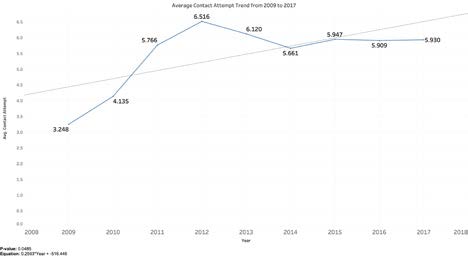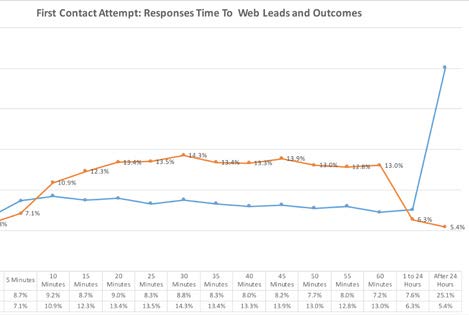
One of the most important elements of successful sales engagement is persistence— how many times you go back to a prospect or lead and connect with him or her. To persist means “to continue steadfastly or firmly in some purpose or course of action.” That’s a fairly accurate depiction of the type of consistent follow-up and determination that yields concrete results for sales professionals.
According to a LinkedIn post by business success expert Angela Smith, 48% of leads never get followed up on by sales representatives, and 25% of the sales professionals stop after the second contact. Another 12% ceased attempts after three contacts. In fact, just 10% of sales professionals persist after three contacts with the prospect.
Maybe that doesn’t sound so bad— after all, they tried a few times, right? But the data shows that two or three attempts just aren’t good enough, because 80% of sales are made after 5-12 contacts (Elkington & Oldroyd, 2016; Haliva, 2015). This research is backed up by the Telfer Study, an extensive report recently conducted by the Telfer School of Management on behalf of VanillaSoft.
Five to twelve contacts— that’s a startlingly large number of touches in order to achieve sales success. The trick, of course, is being persistent without being irritating to your potential client.

 Types of Engagement
Types of EngagementIn the modern era, there are a number of useful ways to engage with a prospect. By using a mixture of these methods, you can figure out which one the client prefers— i.e., which one will be least annoying and most effective.
The types of engagement that seem to work best for modern prospective buyers include phone calls, texts, emails, and instant messages, plus the tried-and-true direct mail piece. According to sales strategists, you’ll see more than double the success rate when you use two communication methods instead of just one with your prospects. An increase of an extra 3-5% occurs when you add in a third communication method.
 Speed-to-Lead
Speed-to-LeadAnother way you can be persistent without damaging the client connection is by helping your sales development representatives become faster and more reliable in their follow-up times. How soon do they get in touch with a prospect after the trigger event? That’s the speed-to-lead, the time that it takes for your team to make the first contact with a new prospect.
The Telfer study shows that the ideal time window for contacting a web lead is between 10 and 60 minutes after they reach out to you. In fact, calling within the first 30 minutes is nearly three times more likely to end in a successful outcome than calling as soon as the lead arrives or waiting more than 24 hours. Unfortunately, an AA-ISP Lead Study found that the average time it takes for sales reps to contact a new lead is 38 hours, and that means you’re leaving a lot of money on the table. Don’t let a hot lead grow cold!
 Sales Cadence
Sales CadenceBeyond engagement methods and speed-to-lead, you enter the more complex area of sales cadence— the rhythm your team uses when contacting a potential customer. How much time elapses before the next followup attempt? What’s the gap between second and third outreach, and so on? The type of messaging, the mode of communication, and the spacing between contact attempts is all crucial to landing that sale.
We’re going to review all of that and show you how patience, persistence, and proactive engagement can revamp your selling strategy and lead to a notable leap in your sales successes. Of course, this rewiring of your current strategy might involve altering your pipeline a bit. You may need to think about new sales engagement software that can quickly route the incoming leads to your reps so you can get in that first contact within the recommended speed-to-lead window.
These are significant changes, and change can be uncomfortable. But with these adjustments comes a dramatic increase in productivity, which leads to a boost in sales— and those extra profits are good for everyone at your company.
Right now, you may be thinking about your star salespeople— about how quick they are to reach the prospects and how many calls they make per day. They're probably working very hard to squeeze in a high volume of calls; but unfortunately, the number of calls per day or hour has no direct impact on win outcomes. The volume of calls alone isn't what makes sales happen— it's the persistence, with the right sales cadence, that leads to a win.
Instead of your reps spinning their wheels, trying desperately to reach goals without seeing many genuine conversions, they may need to refocus on quality, not quantity. Longer calls — which implies a quality conversation is taking place — are linked to an increase in success rates; for example, the Telfer Study shows that "for every increase in a minute in call duration, there is 6 times better odds of success with the lead."
The numbers make sense— if a lead is letting you explain your company's products or services in more detail, you have a better chance to present all the selling points and convince the prospect to make a purchase. You're having a quality conversation, and the potential client is finding it interesting and enjoyable. This type of call is not about quantity; you wouldn't want to hurry to end the call just so you can reach a "call quota" for the hour. Instead, you would spend those extra minutes in the hopes of seeing a successful conversion from lead to customer.

According to Nusair Bawla, writing for Business News Daily, the goal of these longer calls and persistent touches over time is the building of a new relationship. "In building a relationship, you'll develop a much better understanding of the client's needs and wants," Bawla explains. "You'll get to understand their underlying problems, not just the superficial ones that appear obvious. And once the client knows that you understand them, they are yours."
Crafting this kind of trust between a sales rep and a prospect doesn't happen right away; it takes time. That can be frustrating for a busy sales team, especially for the leadership. As a manager or leader in your sales department, you're under pressure to show results, and you know that there are only so many minutes in a day.
It's tougher than ever to reach prospects on the phones; as many people won't answer if they don't recognize the number. It's hard to get responses to emails; so many people have overflowing inboxes, and they just ignore the touches from your sales reps. The customer is in control in the modern era. He decides when, where, how, or if to make contact with salespeople. And that reality can be incredibly frustrating.
That's why it's so essential to develop patience, for yourself and among the sales professionals on your team. Even though the clock is ticking, even though other leads are on the way, take time to listen to the prospects. Give them time to express their needs and space to tell you what they're looking for and why they came to you. It's okay to be silent on the call sometimes, giving them room to think and to answer your questions fully.
To facilitate this transition from a hectic sales atmosphere to a more patient one, you can implement some strategies and tips for improving patience across the spectrum of your sales tasks.
Let's dig a little deeper into the concept of persistence in sales. As we've seen, about 10% of sales are closed after 4 follow-up contacts, while 80% are successfully completed after 5-12 contacts. The fresh data from the recent Telfer Study reveals that "the average number of contact attempts needed for a positive outcome with a lead is 5.7 for B2B companies and 5.9 for B2C companies."

The Telfer Study also shows that for some companies, it's important to make additional contact attempts beyond that 5-12. If you're in a service-oriented industry or in the wholesale business, you'll need to touch that prospect a few more times than your counterparts in other industries do, simply because of the nature of your offering and the nature of the modern customer.
Ideally, your team should use a front-loaded sales cadence, which starts with a high speed-to-lead, packs a higher number of touches into the first week, and then tapers off for upwards of a week before repeating, allowing the prospect time to think while still staying present and visible.
Developing a front-loaded sales cadence that is perfect for your business and your industry will take time and a bit of trial and error. Here are some tips to help you get started.
 Aim to reach hot leads within the first hour. As previously mentioned, the ideal window for your first touch with a prospect is 10-60 minutes after the first contact. Get to them too quickly, and they may be scared off; reach out too late, and they may have moved on.
Aim to reach hot leads within the first hour. As previously mentioned, the ideal window for your first touch with a prospect is 10-60 minutes after the first contact. Get to them too quickly, and they may be scared off; reach out too late, and they may have moved on.As we've seen, the volume of your teams' calls doesn't directly increase sales success; it's more about the number of contacts with the prospect and the quality of those touches. Quality goes deeper than simply talking longer during a call; it also has meaning for engagement methods like voicemails, emails, and messages.
 The Personal Touch
The Personal TouchDo your reps use templates? Templates are an excellent time-saving tool— unless they are misused. If a rep fails to personalize the template or sends the same one again to the same prospect, the rep is sabotaging his or her own efforts to close that sale.
In the same way, leaving the same voicemail over and over is counterproductive. In order to make contact effective, your reps need to bring something new to the table every time, whether it's a fresh selling point, a special deal, or an extra bit of information to create interest.
 The Value of Sales Experience
The Value of Sales ExperienceTraining is crucial here. The Telfer research unveiled an important link between a sales rep's level of experience and his or her chances of closing sales successfully. The greater the experience, the higher the likelihood of success.
Your newer, younger hires won't have the same experience as the veterans in your department; but you can help them get there with training. In fact, your veteran salespeople could probably use a refresher course as well, especially if you're implementing new sales engagement software and altering your sales cadence.
Offer plenty of hands-on training, as well as practice runs and role-playing sessions. As your team learns to implement new strategies and try fresh approaches, they will gain the confidence they need to move forward and close sales.
Experienced engagement involves several skills. With the right program, you can build these vital skill sets in your sales reps. Think of this effort as an investment in future sales success, with a guaranteed ROI.
 Teach listening skills. Your reps need to know when to be quiet, how to absorb what the prospect is telling them, and how to use that fresh knowledge to inform the rest of their sales pitch. In addition, the listening skills you teach your sales reps should help them to better adapt, during the call, the rest of their pitch approach. For example, some people hate being asked open-ended questions, and so your reps should be trained on how to identify those prospects and steer the conversation appropriately.
Teach listening skills. Your reps need to know when to be quiet, how to absorb what the prospect is telling them, and how to use that fresh knowledge to inform the rest of their sales pitch. In addition, the listening skills you teach your sales reps should help them to better adapt, during the call, the rest of their pitch approach. For example, some people hate being asked open-ended questions, and so your reps should be trained on how to identify those prospects and steer the conversation appropriately. Encourage reps to briefly research a prospect before making the call. It's helpful to know something about a prospective client's background, location, age, and other demographics before calling. This way, your rep can craft a more customized sales strategy and begin the call on a more personal, conversational note. Social selling, or warming up the lead, often leads to longer conversations and more positive contacts in the future.
Encourage reps to briefly research a prospect before making the call. It's helpful to know something about a prospective client's background, location, age, and other demographics before calling. This way, your rep can craft a more customized sales strategy and begin the call on a more personal, conversational note. Social selling, or warming up the lead, often leads to longer conversations and more positive contacts in the future.Give your sales reps fresh strategies and training, and you'll see them improve their success rates as they gain experience, but those elements can only take your team so far. In the digital age, it's vital to have sales engagement software that supports and facilitates what you're trying to accomplish with your team.

Customer relationship management (CRM) software that takes a list-based approach doesn't really support this type of strategic sales plan. A list-based system steals precious time from your reps and doesn't facilitate the type of rhythmic, repeated follow-up your reps need to do. CRM software and marketing automation systems too often fail to efficiently prioritize leads, or they don't work smoothly together. Understandably, this can cause stress, distraction, and wasted time for your team.
Instead of list-based systems, consider queue-based sales engagement software that quickly and smoothly doles out the hot leads, automates sales cadence, and streamlines the follow-up process for your reps.
To further simplify the reps' roles, create one team whose sole job is qualifying leads using a sales engagement platform like VanillaSoft, and form another team that manages the much smaller list of sales opportunities from those qualified leads that have been identified using a CRM platform.
Said another way:
Want to hear what other sales professionals have to say when it comes to persistency in sales? Get your on-demand copy of the sales persistency webinar - Pump Up Your Deals by 56%: Patience, Persistence, and Proactive Engagement.
I am extremely impressed with how easy it was to get started and train my marketers on the VanillaSoft solution. As well, I had a lot of flexibilityon how I wanted this program to run for our company. Plus, customer service is EXCELLENT at VanillaSoft. I highly recommend VanillaSoft to anyone!

Jody Weinberg J Telecommunications
We have never been so successful. Since we started using VanillaSoft we have increased productivity by 175%! Also, working with the VanillaSoft team has been an incredible experience. They helped us customized our campaigns and page layout to fit our unique needs.

Lauren E. Siegel Michigan Hillel